Submission and Validation Process
This section sets out the detailed recommendations regarding the submission of data to the national database managed by AMHOCN under contract to the the Australian Government Department of Health and Aged Care.
Overview and timelines
The NOCC Technical Specifications outline the reporting requirements for provision of the NOCC dataset by States and Territories to the Australian Government.
In December 2022 the NOCC was established as a combined National Minimum Data Set (NMDS) and National Best Endeavours Data Set (NBEDS) by the National Health Data and Information Standards Committee (NHDISC) . Version 2.11 of the NOCC Technical Specifications represents implementation of the new metadata standards.
Under the Agreement each State and Territory has with the Australian Government, a complete and final extract covering the full financial year ending June 30 of the current calendar year is required to be submitted by 31 December following the end of that financial year.
To ease administrative burden and quicken the process, States and Territories are required to submit data directly to AMHOCN. The Australian Government has advised that final extracts of NOCC data submitted to the AMHOCN Data Bureau will be deemed to be fulfilment of the funding agreement requirements in respect of the submission of NOCC data to the Australian Government.
It is assumed that States and Territories will build an automated or semi-automated process that enables NOCC data to be extracted from source systems. That process would bring together the data from all relevant source systems, apply any transformations and restructuring to the data that was needed to bring it into conformance with the NOCC specifications, and then write the data out as a single extract file in the required format.
AMHOCN data is submitted via the MDS Validator (WebVal). The MDS Validator allows States and Territories to upload their .DAT file to a secure server. Once the upload and validation process is complete (which can take some time depending on the size of the file) States/Territories will be sent an e-mail informing them of the status of the file and providing a link to the online reports. Note that States/Territories may zip their file prior to upload in order to reduce the size of the file. This zip file must not be password protected. The upload link itself is encrypted so the file does not travel across the Internet unprotected.
AMHOCN understands that data uploaded to the online validator may not be States/Territories final version ready for submission and therefore, until States/Territories make the decision to submit their file via the online validator, the upload remains in a private workspace inaccessible to anyone other than the submitting State/Territory. It is also possible to completely delete the file after validation in order to remove the data from the system.
Note that the Stand Alone Validator is no longer supported and online validation is the required validation and submission method. Please refer to the MDS Validator documentation for more details on using the MDS Validator. Contact AMHOCN at support@amhocn.org if you require more information about the submission process. For MDS Validator specific support please contact support@validator.com.au.
The NOCC Technical Specifications describe the two business rules that apply to episodes of mental health care:
- One episode of care at a time
- Change of setting implies a change of episode
One episode at a time: While an individual may have multiple episodes of mental health care over the course of their illness, they may be considered as being in only one episode at any given point of time for a particular Mental Health Service Organisation. The practical implication is that the care provided by a Mental Health Service Organisation to an individual consumer at any point in time is subject to only one set of reporting requirements. Where a person might be considered as receiving concurrently two or more episodes of mental health care by virtue of being treated by the organisation in more than one setting simultaneously, the following order of precedence applies: Inpatient, Community Residential, Ambulatory.
Change of setting = new episode: A new episode is deemed to commence when a person’s care is transferred between inpatient, community residential and ambulatory settings. A change of Episode Service Setting therefore marks the end of one episode and the beginning of another.
When the source data hasn’t been collected in this manner then some massaging could correct Sequence errors and reduce overall data loss. These guidelines are suggestions for possible ways to resolve some of these issues, but the details of the resolution used is best judged by the submitting jurisdictions in light of their collection systems and protocol.
The NOCC Validator and other data processes apply these rules strictly to submitted data, which in cases of overlapping care periods in submitted data leads to errors and the filtering of conflicting data. Within the Validator these are called “Sequence” errors and are attached to the COD records causing the conflict.
While clinical practice and data collection commonly accept overlapping data, overlaps should be removed for the purposes of NOCC submissions. As a matter of policy, AMHOCN does not edit submitted data, but we would like to enable submitters to better analyze, correct and filter NOCC data submissions to reduce or eliminate all Sequence errors.
Reporting of Sequence issues has evolved over the years, but by using the Online Validator we hope to be able to provide timely and useful reports on episode sequencing problems, aiding their resolution and removal.
To that end, AMHOCN is emphasising the issue and hope to enlist the help of jurisdictional submitters.
Goal 1: Improve Reporting of Sequence Errors
There is already basic reporting of “Sequence” errors, but AMHOCN would like to improve this. Submitter feedback on the type of reports or documentation that would be useful in building a protocol complying file would be invaluable.
Goal 2: Reduce Sequence Errors
The reporting in Goal 1 is primarily to enable submitters to build Sequence error free files. We envisage that some informed massaging of data may be required and submitter feedback on the required support is always invaluable.
Guidelines for meeting the NOCC Protocol
The NOCC Technical Specifications require non-overlapping episodes. When the source data hasn’t been collected in this manner then some massaging could correct Sequence errors and reduce overall data loss. These guidelines are suggestions for possible ways to resolved some of these issues, but the details of the resolution used is best judged by the submitting jurisdictions in light of their collection systems and protocol.
This is a guide only. The suggestions should be evaluated for their applicability by each jurisdiction.
Sequence Short-hand
This information and images contain short codes to refer to sequences:
- “A”, “R”, and “D” indicate Admission, Review and Discharge respectively.
- “i”, “r”, and “a” indicates Inpatient, Residential and Ambulatory respectively.
So “Ai” is an inpatient admission, “Rr” is a residential review and “Da” is an ambulatory discharge. The images below are available with the Validator from the individual COD record view by clicking “Person and Episode View”.
Administratively Added CODs
If data is being collected on overlapping episodes then it may be possible to insert “Administrative” admissions and discharges to produce a one-episode-at-a-time NOCC file. Whether this is applicable will depend on the nature of each jurisdiction’s data collection systems and processes.
For example, a sequence like Aa Ai Di Da, as illustrated, could be presumed to have overlapping episodes:
Sequence with overlapping episodes
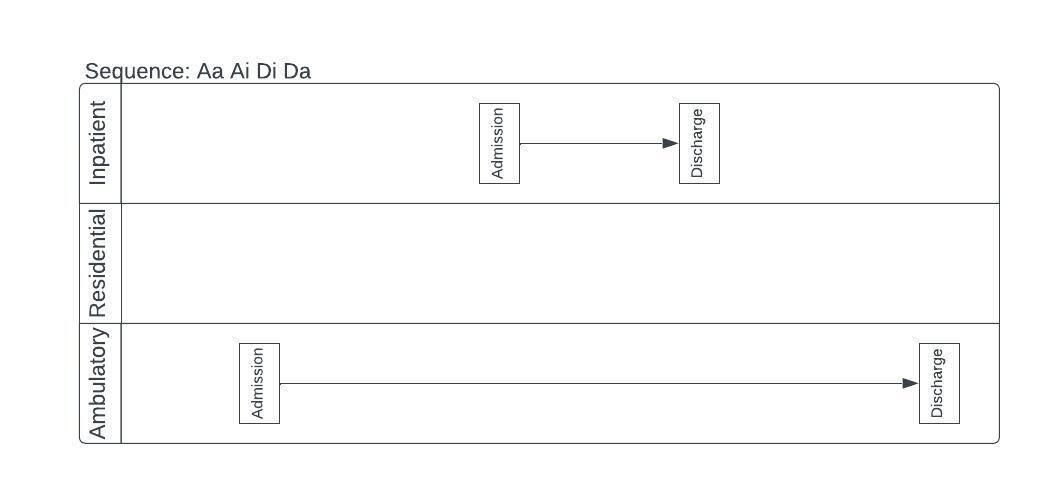
Two “Administrative” COD records could be added to split the ambulatory episodes into the section before the inpatient episode and the section after. These are the new “Da” and “Aa” occasions.
Adding "Administrative" COD records to a sequence with overlapping episodes

Date Adjustments
Sequence errors are commonly due to small date discrepancies. It may make sense to move an ambulatory discharge earlier so that it is on the same day as the inpatient admission, or similar changes in similar circumstances. This may depend on whether dates are being recorded accurately or are sometimes delayed.
For example, the Aa Ai Da Di sequence illustrated has the ambulatory discharge (Da) recorded 2 days after the inpatient admission (Ai):
Sequence with ambulatory discharge recorded 2 days after the inpatient admission
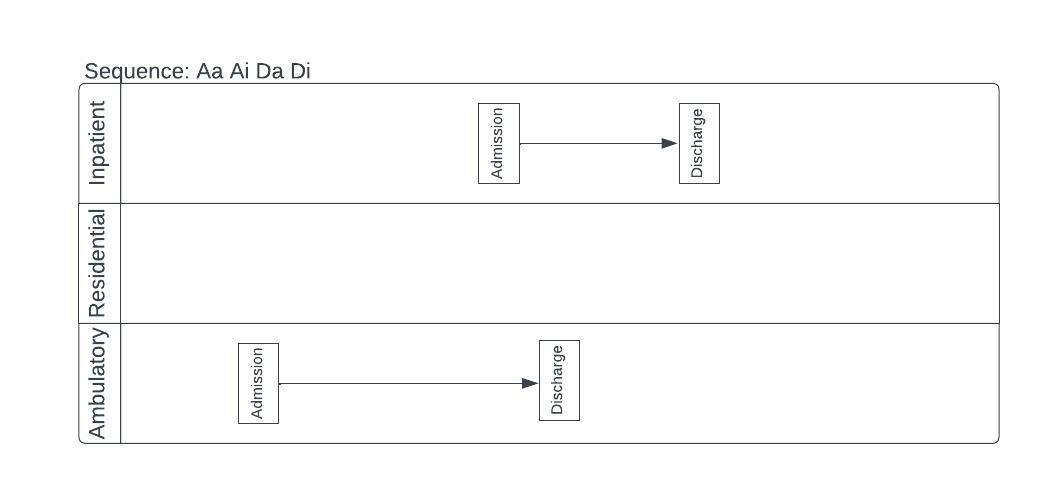
The Da could be re-dated two days earlier to match the Ai, resolving the Sequence error:
Ambulatory discharge has been red-dated two days earlier
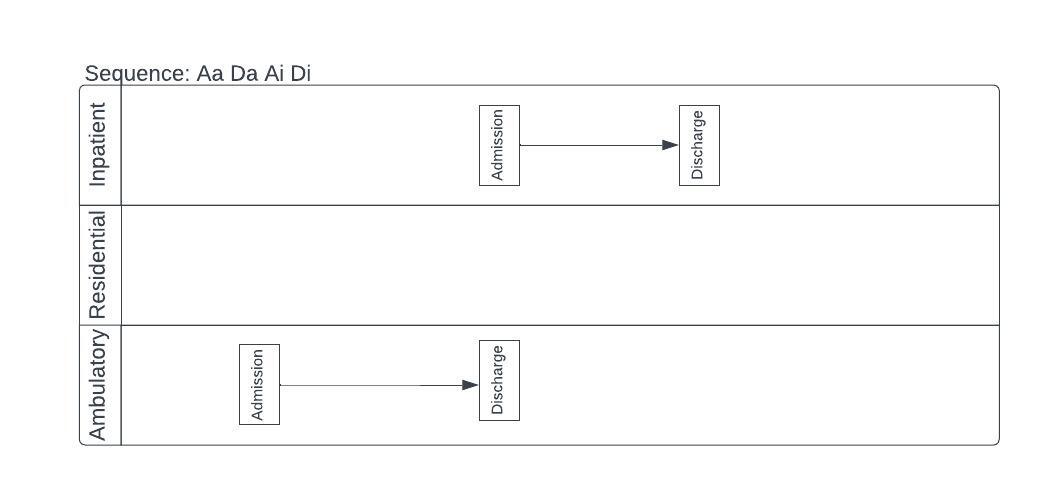
Again, this may or may not be appropriate for your jurisdiction.
Another example sequence Aa Ai Ra Di Da:
Example sequence Aa Ai Ra Di Da
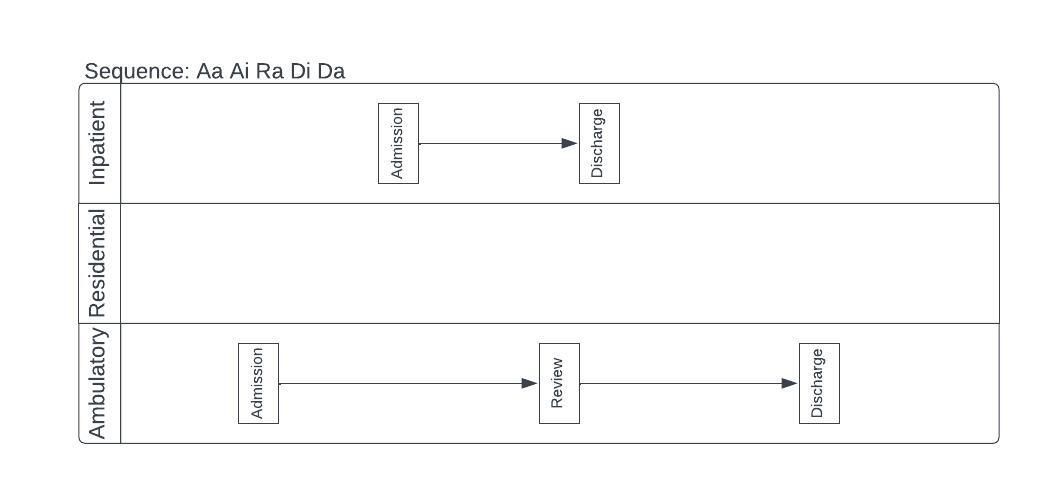
Could be resolved either by dropping the Ra:
Resolved by dropping the Ra
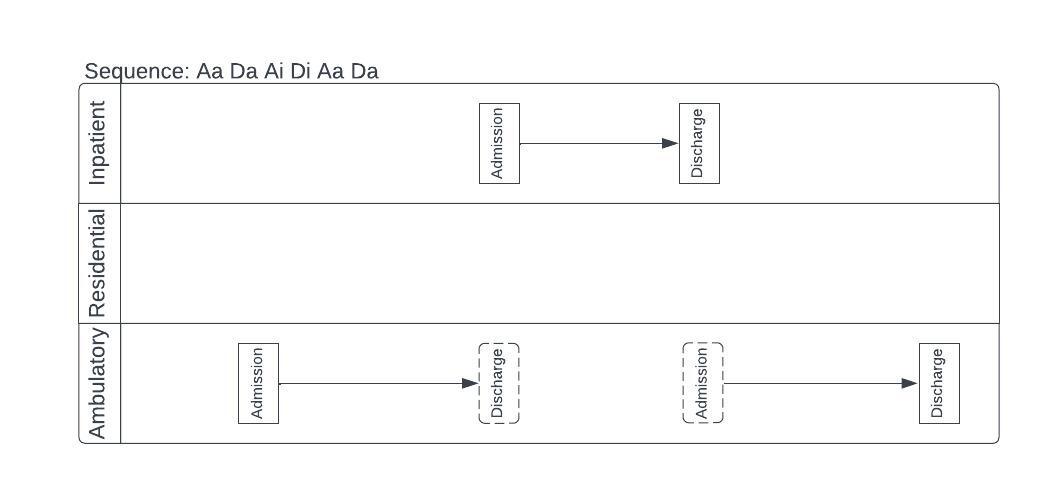
Or moving it outside of the inpatient episode:
Ra moved outside the inpatient admission
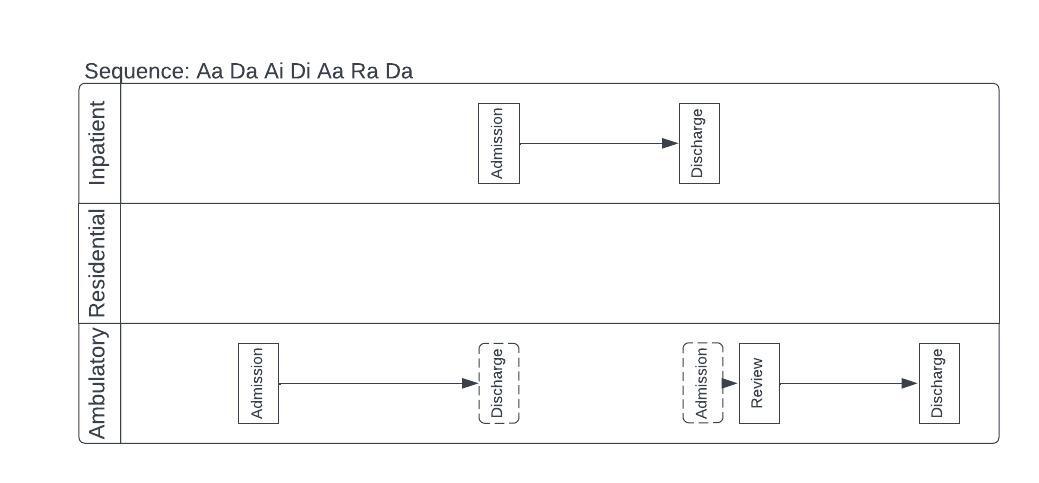
Dependent Measures
Administratively created COD records could have the measures from neighbouring CODs attached if appropriate. For example, an administratively created discharge from ambulatory care could be given a copy of the HONOS from the Inpatient admission occurring on the same day.
EpiId Handling
The COD record’s EpiId field should be unique, meaning if an episode is split by an intervening episode in another setting, then there should be two different EpiId values. See: https://webval.validator.com.au/metadata/NOCC/02.11/COD/EpiId
Our Episode Checking Process
The process we use to find Sequence errors has been of interest so a summary is included.
- Collect all CODs for a Person within an ORG
- Sort them by collection date
- Resolve same-day ordering by minimizing sequence errors and tie-break heuristics
However, we think focusing on the algorithm is not likely to be of benefit.
Our first principle is to not change the data you submit in any way, so any correction should be applied to submitted data. We would like to help with the generation of correct files.
Note that the EpiId is not used in our sequencing algorithms and tie-breaking heuristics.
Not all jurisdictions submit this identifier and our earlier investigations indicated that it did not resolve the majority of sequencing errors. It may, however, be useful at a jurisdictional level ‘pre-submission’.
